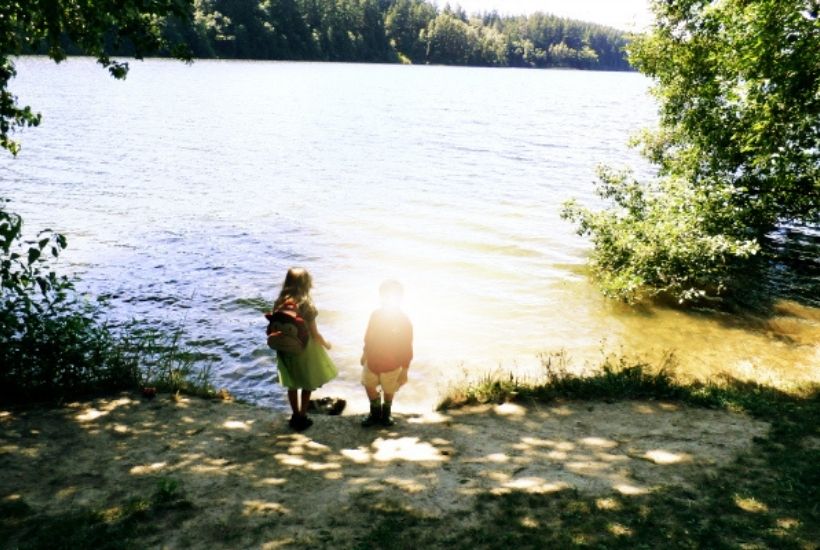Love the Chaos: How to Enjoy Homeschooling Multiple Ages
This post may contain affiliate links. For more information, please read my disclosure policy.
Homeschooling multiple ages is like running a 3 ring circus, but with a few tips, you can become the ringmaster instead of the clown chasing the burning house.
Tapestry of Grace, a curriculum designed for homeschooling multiple ages, sponsored this post. In the interest of disclosure, I purchased all 4-year plans of Tapestry of Grace, and I’m starting my 7th year of using Tapestry of Grace with my own children. All opinions are my own honest opinions.
Have you ever been to the circus and seen the clowns trying to put out a house fire? They’re dashing around and around as flames leap higher and higher. Horns are beeping. The clowns are jumping up and down. It’s hilarious until we’re at home.
Danny’s complaining about doing math while poking his screaming sister with a pencil. Grabbing your sleeve, your 6yo shoves his newest artwork in your face. Meanwhile, your toddler’s happily stuffing toilet paper down the toilet. You don’t need to take your kids to the circus. Your house is a 3 ring circus!
Enjoy Homeschooling Multiple Ages
Combine Children Wisely
For your own sanity, combine children as much as possible. But let’s discuss what I mean by combining for a second.
Combining means I have my children studying the same historical time period. For instance, everyone will be studying World War 2 this fall in Tapestry of Grace. However, my little 1st and 2nd graders will NOT be reading the same material as my high school teenagers.
My teenagers will be studying Stalin, Mussolini, the Nazis, and the horrors of WW2.
My little 1st and 2nd graders will read about the little boats of Dunkirk, the Story of Anne Frank, and Franklin D. Roosevelt.
But I’m not going crazy trying to cover both WW2 and the Reformation.
Combine Enrichment Studies
Combining children wisely means you can enjoy the same enrichment movies for family movie night. The family can take the same field trips. You can complete family projects together.
For instance, you can assign your 9th grader to write a play about WW2 and use your elementary children to perform the play. The family can create a newspaper about WW2 with all the children submitting articles about what they learned.
You can hold family discussions at the dinner table and everyone will be included.
Combining children can also mean combining children for art. Assign your older children to read a book about an artist or style. For instance, have your children study impressionism. Then pick out an art project or two for all the children to complete. Even toddlers love painting and playing with clay!
Do the same thing for music. Assign the older children to read about the history of Jazz, and then turn on Jazz for everyone to enjoy.
Nature study works the same way. Choose a topic for older children to study in detail. They can learn about pine trees and create a notebooking page. Now go for a nature hike. Your toddlers can practice identifying trees while older children learn to tell the difference between the various types of pine trees.
Remember to pack a backpack with journals and colored pencils for each child.
Do Not Combine Skill Subjects
While combining content subjects saves your sanity, do not combine math and language arts. These are skill subjects that are better-tutored one-on-one.
Even twins don’t move at the same pace through their studies. One will race ahead in math while the other excels at reading.
Everyone will be happiest if you keep the skill subjects divided. Your kids will be able to blossom in their own time without waiting for a sibling to catch up to them.
Do not combine any subject which depends upon a skill set being mastered before progressing.
You can learn about the Civil Rights Movement without having studied the Great Depression. However, it’s impossible to understand multiplication if you’re unable to add.
To be honest, I’m of two minds about Latin. I’ve tried to teach it as a group, but it seems to work better as a skill subject because kids need to master one area before moving on to the next. Quite frankly, a 9-year-old learns faster than a 7-year-old.
However, there are many fun extras, such as singing songs and learning prayers, which work well as a group.
Remember the goal is to enjoy running our 3-ring circuses. Combine subjects that allow you to enjoy group projects as a family, to enjoy movies and field trips together.
Don’t combine subjects that will cause you to become a tightrope walker, constantly trying to balance between moving too fast for one child and too slow for the other.
Related:
Schedules to Balance Homeschooling Multiple Ages
Unfortunately, we’re never given enough time, especially when we’re homeschooling multiple ages. Toddlers need supervision, play, and cuddles. Preschoolers want messy and fun activities. Elementary children thrive with one-on-one tutoring in reading, writing, and arithmetic. Middle school children argue with you about everything under the sun. High school teens are ready for long. meandering discussions.
How can you give each child what they need? Schedules!
You a daily meeting with each child. During this time, discuss the math and grammar lessons. Check homework and tests. Ensure your children have actually done the work!
You’re giving your children one-on-one tutoring.
But you know the other kids will get into trouble the moment you turn your back, so have a plan. Assign the older children to play with the toddlers and preschoolers while you’re meeting with a sibling.
- Rotate the children through special playtime throughout the day.
- Send the kids to play in the backyard for 30 minutes.
- Assign independent work. Encourage free reading.
- Alternate time on the computer
- You can even turn on a movie or science documentary for the youngest children in a pinch.
During nap or quiet time, hold weekly discussions with middle school and high school students. You’ll have the time you need for a meandering discussion which melds history and current events. Serve tea and cookies so your younger kids can sit and participate, especially if all the children are studying the same time period.
It’s amazing how often my elementary kids will be able to pipe up with a well-timed comment from their Tapestry of Grace studies.
So create a good schedule that will keep you the ringmaster of your 3-ring circus! You’ll enjoy a good balance for homeschooling multiple ages.
Related:
- Create a Daily Schedule for a Well-Run Homeschool
- Top 10 Steps to Creating a Daily Schedule
- A Homeschool High School Schedule
Morning Time
One of the problems of homeschooling multiple ages is getting worn down. You begin skipping the good and beautiful in favor of the essentials.
This isn’t to say your kids don’t need to learn to read, write, and do math. But that’s not all there is to life. The goal of classical education isn’t to get your kids into the best colleges and careers. The goal is to educate our children’s minds, bodies, and souls.
And the very best way to educate our children’s souls is through morning time.
The very first thing you should do in the morning is a morning meeting with your children. Keep it short. Keep it sweet. And keep it beautiful.
This is the time to add poetry memorization, to work through Shakespeare’s plays, to memorize Latin prayers. Enjoy group art projects, indoor nature study, and music appreciation. Don’t worry about what’s covered and what isn’t.
Grab the kids, turn on music, and enjoy time together.
Homeschooling is a lot more enjoyable when you have a time and place for the best things homeschooling can offer.
Related:
- How to Create Morning Time Plans with Tapestry of Grace
- 5 Tips to Getting Started with Morning Time
- Morning Time & The Well-Run Homeschool
Plan a 4-Day Week
4-day weeks are a carefully kept homeschooling secret. Most homeschoolers, myself included, use 5 days for homeschooling.
However, if you keep one day free each week, you’ll have time for long field trips, creative art projects, and even cleaning the house.
You’ll have built-in make-up days for those days nothing goes right. Those days the toddler shoves a toy down the toilet, your 1st and 3rd graders dug up the yard looking for dinosaur bones, and your 6th grader had a meltdown over math.
Just remember to keep your day off light, fun, and cheerful.
Plan a picnic lunch, a trip to the museum, or that extravagant history project you never have time to complete.
And you don’t need to have your free day on Fridays. Experiment with the various days of the week. Try having Wednesdays off every single week and see what it does to your energy levels on Thursday and Friday.
Consider what would happen if you begin the week by using Mondays to get all those nagging loose ends accomplished.
- Clean house
- Grocery shopping
- Field trips
- Plan the week
- Music lessons
- Playdates with friends
You never know, starting the homeschool week on Tuesday with a clean plate may be just the ticket for you to be able to truly enjoy homeschooling multiple ages.
Experiment with a 4-day week and discover the joys it will bring to your homeschool!
 Tapestry of Grace
Tapestry of Grace
Tapestry of Grace is designed to allow you to enjoy balancing multiple ages while homeschooling. You’re given delightful activities for each age and projects for the entire family.
You no longer need to spend your weekends flipping through various teacher’s manuals praying you’re not forgetting anything. Instead, you open to the weekly plan, and everything you need for all the children in your family is laid out for you.
Hands-on projects are included for your tactile learners. Extra books are suggested for your avid readers. Discussion questions are given so you can enjoy in-depth discussions with your children.
Tapestry of Grace has everything you need to truly enjoy homeschooling multiple ages.
Related:
- Expand the Learning with Tapestry of Grace Lapbooks
- 10 Exciting Ways to Enjoy History in Your Homeschool
- An Introduction to Tapestry of Grace
Learn more about Tapestry of Grace and the benefits it can offer your family.
When you homeschool multiple ages, you’re the ringmaster of a 3-ring circus. Something is happening all over the house!
But you can enjoy homeschooling multiple ages when you tame the chaos. Just remember to combine the kids using a curriculum like Tapestry of Grace, schedule, enjoy morning meetings, and take a day off every week.
You’ll soon discover it’s fun to homeschool a large family!









